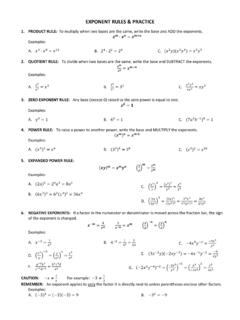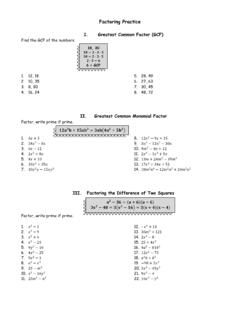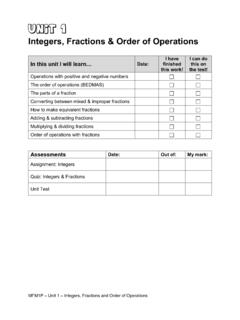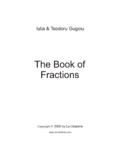Transcription of Adding & Subtracting Rational Expressions
1 Adding AND Subtracting Rational EXPRESSIONSADDING AND Subtracting Rational EXPRESSIONSADDING AND Subtracting Rational EXPRESSIONSADDING AND Subtracting Rational Expressions To To To To Add or Subtract Two FractionsAdd or Subtract Two FractionsAdd or Subtract Two FractionsAdd or Subtract Two fractions Example 1 Example 1 Example 1 Example 1 a) a) a) a) Add &'() *'( b) b) b) b) Subtract +,- ', Solution: a) a) a) a) &'() *'(/& 0 *'(/ '+'( b)b)b)b) +,- ',/+ 1 ',/ 2, The same principles apply when addingaddingaddingadding or Subtracting Rational expressionssubtracting Rational expressionssubtracting Rational expressionssubtracting Rational Expressions containing variables. To To To To Add or Subtract Rational Expressions with a Common DenominatorAdd or Subtract Rational Expressions with a Common DenominatorAdd or Subtract Rational Expressions with a Common DenominatorAdd or Subtract Rational Expressions with a Common Denominator 1.
2 Add or subtract the numerators. 2. Place the sum or difference of the numerators found in step 1 over the common denominator. 3. Simplify the faction if possible. Example 2 Example 2 Example 2 Example 2 Add (; 1 +); 0 <; 1 + Solution: (; 1 +) ; 0 <; 1 +/( 0=;0<); 1 +/ ; 0 *; 1 + Example Example Example Example 3333 Add ;>0?;1<=;0+)=;1<)) 2;0'<=;0+)=;1<) Solution: ;>0?;1<=;0+)=;1<)) 2;0'<=;0+)=;1<)/ @;>0?;1<A0 =2;0'<)=;0+)=;1<) Write as a single fraction. Remove parentheses / ;>0?;1< 0 2;0'<=;0+)=;1<) in the numerator. / ;>0&;0'C=;0+)=;1<) Combine like terms. / =;0+)=;0<)=;0+)=;1<) Factor. / =;0+)=;0<)=;0+)=;1<) / =;0<)=;1<) Divide out common factors.
3 When Subtracting Rational Expressions , nWhen Subtracting Rational Expressions , nWhen Subtracting Rational Expressions , nWhen Subtracting Rational Expressions , note that theote that theote that theote that the entire numerator of the second fractionentire numerator of the second fractionentire numerator of the second fractionentire numerator of the second fraction =not just the first term) must be be be be subtracted. Also note that the sign of each term of the numerator being subtracted will change when the parentheses are removed. Example Example Example Example 4444 Subtract ;>1<;0?;>0&;0'<- ;>1 2;1+;>0&;0'< HI) JI/H)JI, IKL HI- JI/H-JI, IKL Solution: ;>1<;0?;>0&;0'<- ;>1 2;1+;>0&;0'</ =;>1<;0?)1=;>1 2;1+);>0&;0'< Write as a single fraction. Remove parentheses / ;>1<;0?
4 1;>02;0+;>0&;0'< in the numerator. / <;0*;>0&;0'< Combine like terms. / <=;02)=;0?)=;02) Factor. / <=;02)=;0?)=;02) / <;0? Divide out common factors. FINDING THE LEAST COMMON DENOMINATORFINDING THE LEAST COMMON DENOMINATORFINDING THE LEAST COMMON DENOMINATORFINDING THE LEAST COMMON DENOMINATOR When you add or subtract fractions , you begin by finding a common denominator. This is what you must do when you add or subtract Rational Expressions . We seek the least common denominator, LCD, because this produces the easiest calculations. You can add or subtract Rational Expressions only when you have a common denominator. Here the least common denominatorleast common denominatorleast common denominatorleast common denominator, LCD, of a collection of denominators is the smallest expression that is divisible by each of the given denominators .
5 This is equivalent to saying that the least common denominator is the least common multiple, LCM, of all denominators in the collection. To Find the Least Common Denominator of Rational ExpressionsTo Find the Least Common Denominator of Rational ExpressionsTo Find the Least Common Denominator of Rational ExpressionsTo Find the Least Common Denominator of Rational Expressions 1. Factor each denominator completely. Any factors that occur more than once should be expressed as powers. For example, =Q-3)=Q-3) should be expressed as =Q-3)< 2. List all different factors =other than 1) that appear in any of the denominators . When the same factor appears in more than one denominator, write that factor with the highest power that appears. 3. The least common denominator is the product of all the factors listed in step 2. Example 1 Example 1 Example 1 Example 1 Find the least common denominator.
6 '+) 'R Solution: The only factor =other than 1) of the first denominator is 5. The only factor =other than 1) of the second denominator is y. The LCD is therefore 5 y / 5y. Example 2 Example 2 Example 2 Example 2 Find the LCD. <;>-?&; Solution: The factors that appear in the denominators are 7 and x. List each factor with its highest power. The LCD is the product of these factors. Highest power of x LCD / 7 Q< / 7Q< Example 3 Example 3 Example 3 Example 3 Find the LCD. ''*;VR) +<&;>RV Solution: Write both 18 and 27 as products of prime factors: 18 / 2 3< and 27 / 3?. ''*;VR) +<&;>RV/ '< ?>;V R )+?V;>RV The factors that appear are 2, 3, x, and y. List the highest powers of each of these factors. LCD / 2 3? Q? X?/ 54Q?X? Example 4 Example 4 Example 4 Example 4 Find the LCD.
7 +;- &R;0? Solution: The factors in the denominators are x and =x)3). Note that the x in the second denominator, x)3, is a term, not a factor. LCD / x =x)3) Example Example Example Example 5555 Find the LCD. &?;>1 (;) ;>;>1 2;02 Solution: Factor both denominators . &?;>1 (;) ;>;>1 2;02 / &?;=;1 <)) ;>=;1<)=;1<) / &?;=;1 <)) ;>=;1<)> The factors in the denominators are 3, x, and =x-2). List the highest powers of each of these factors. LCD / 3 Q =Q-2)</ 3Q=Q-2)< After you have determined the least common denominator of the given denominators , the task becomes one of writing each given expression as an equivalent expression whose denominator is the LCD. This process is illustrated in the following examples. Example 1 Example 1 Example 1 Example 1 Write the fraction ,*Z[> as an equivalent fraction with a denominator of 4LI<\<.]
8 Solution: ,*Z[>/ ]2CZ>[> To obtain the desired denominator we must multiply the numerator and denominator by additional factors of 5 and c, thus ,*Z[> x +Z+Z/ 2+Z2CZ>[> Example 2 Example 2 Example 2 Example 2 Write the fraction +^<=^1_) as an equivalent fraction with a denominator of `=a<-b<). Solution: +^<=^1_)/ ](=^>1_>) +^<=^1_)/ ]< ? =^0_)=^1_) We need additional factors of 3 and m)n in our denominator. Hence, we multiply the numerator and denominator by them to obtain the desired denominator. Thus +^<=^1_)x ?=^0_)?=^0_)/ '+^=^0_)(=^0_)=^1_) or'+^=^0_)(=^>1_>) Example 3 Example 3 Example 3 Example 3 Write RR0< as an equivalent fraction with a denominator of -2X<-1LX -12. Solution: -2X<-1LX -12 factors into -2=y)3)=y)2). We must multiply the numerator and denominator by -2=y)3). Hence RR0<x 1<=R0?]
9 1<=R0?)/ 1<R=R0?)1<R>1'CR1'< The total process of Adding or Subtracting Rational Expressions uses finding the LCD and writing equivalent fractions . The complete list of steps is below. To To To To Add or Subtract Two Rational Expressions with Unlike DenominatorsAdd or Subtract Two Rational Expressions with Unlike DenominatorsAdd or Subtract Two Rational Expressions with Unlike DenominatorsAdd or Subtract Two Rational Expressions with Unlike denominators 1. Determine the LCD. 2. Rewrite each fraction as an equivalent fraction with the LCD. This is done by multiplying both the numerator and denominator of each fraction by any factors needed to obtain the LCD. 3. Add or subtract the numerators white maintaining the LCD. 4. When possible, factor the remaining numerator and simplify the fraction. Example 1 Example 1 Example 1 Example 1 Add &;) ?
10 R Solution: First we determine the LCD. The LCD / xy. We write each fraction with the LCD. We do this by multiplying bothbothbothboth the numerator and denominator of eacheacheacheach fraction by any factors needed to obtain the LCD. In this problem, the fraction on the left must be multiplied by RR and the fraction on the right must be multiplied by ;;. &;) ?R/ &; cRRd) ?R c;;d / &R;R)?;;R By multiplying both the numerator and denominator by the same factor, we are in effect multiplying by 1, which does not change the value of the fraction, only its appearance. Thus, the new fraction is equivalent to the original fraction. Now we add the numerators, while leaving the LCD alone. &R;R)?;;R/ ;R or ?;0&R;R Example 2 Example 2 Example 2 Example 2 Add +2;>R) ?'2;RV Solution: The LCD is 28Q<X?. We must write each fraction with the denominator 28Q<X?


















